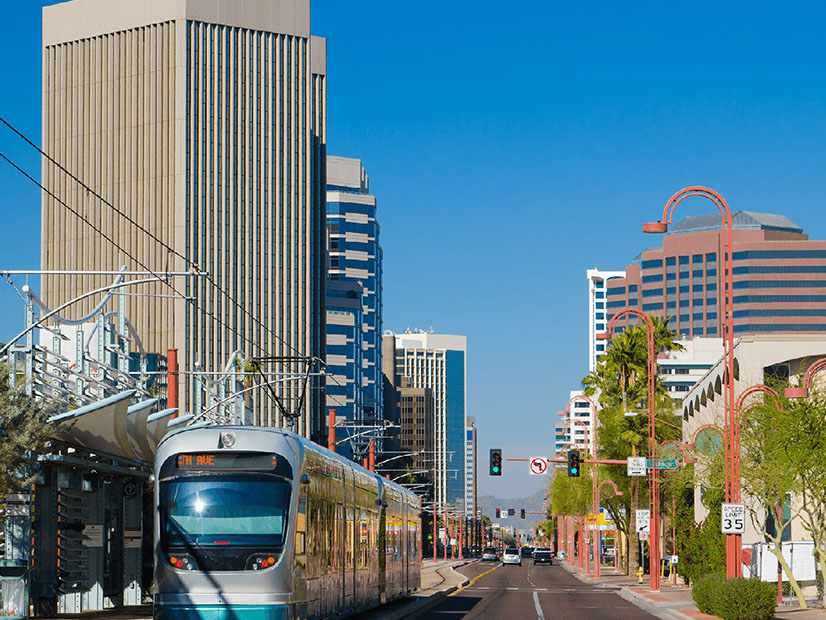
Arizona’s public utilities could use current technology to get to 80% clean electricity while maintaining reliability and cost-effectiveness, according to a consultant’s report prepared for the Arizona Corporation Commission.
But going from 80% to 100% clean energy would be more of a challenge, said the report from Ascend Analytics and Verdant Associates.
“Cost-effectively achieving higher than 80% clean energy while maintaining reliability requires innovation in clean energy technologies, such as green hydrogen, long-duration storage, advanced nuclear, or something else we haven’t thought of yet,” Ascend said in presenting its findings to the commission on Tuesday.
ACC asked for the analysis to see how much customers’ electric bills would change under the commission’s proposed energy rules.
The rules would require the state’s electric utilities to cut carbon emissions 50% by 2032 and 100% by 2070. ACC voted in May to advance the rules, which still must return to the commission for final approval. (See Arizona Regulators Revive Clean Energy Rules.)
80%, 100% Scenarios
Ascend’s analysis looked at the impact of an 80% and a 100% clean energy requirement for electric utilities by 2050, as compared with a “least-cost” case. The least-cost scenario is based on a “traditional approach” to resource acquisition, Ascend said, including natural gas turbines for capacity, a reduction in energy efficiency savings over time and the addition of low-cost renewable energy.
In comparing the 100% clean energy scenario to the least-cost case in 2050, monthly electric bills would be $22 to $24 higher for customers of Arizona Public Service (APS); $8 to $28 higher for customers of Tucson Electric Power Co. (TEP); and $33 to $35 more for customers of UNS Electric (UNSE). Those figures are in 2021 dollars.
Shorter term, the differences are less. In 2035, monthly electric bills in the 100% clean energy scenario would be $9 to $10 higher for APS customers as compared to the least-cost case; zero to $8 more for TEP customers; and $12 to $20 higher for UNSE customers.
According to Ascend, the most significant cost increases in its analysis would occur from 2040 to 2050 in the 100% clean energy scenario, as the utilities moved beyond 80% clean energy.
“This is due to the need to convert natural gas-fired power plants to burn expensive green hydrogen and add longer duration storage (eight to 100 hours) required for capacity and reliability,” Ascend said.
Ascend noted that a recent report from the National Renewable Energy Laboratory (NREL) also found increasing costs as the power system gets closer to 100% clean energy.
“Our results highlight that getting all the way to 100% renewables is really challenging in terms of costs, but because the challenge is nonlinear, getting close to 100% is much easier,” NREL Senior Energy Analyst Wesley Cole said when the report was released.
Ascend also pointed to the difficulty of making longer-term projections.
“As with any very long-range study, results in the distant future must be taken somewhat with a grain of salt,” the consultant said. “We have little information as to what technologies will be available or how exactly the power system will evolve.”
Ratepayers Weigh In
The commission met on Tuesday and Wednesday to review the Ascend report, ask questions and hear public comments.
ACC also held three virtual town hall meetings last week to hear from ratepayers on potential cost impacts of the proposed energy rules.
Many of the town hall speakers said they weren’t concerned about increased electric bills if it meant progress in fighting climate change.
Lynne Jaffe, a retired schoolteacher, said her son grew up in Arizona and loved the state. But now, because of the heat and drought, he won’t consider living there, she said.
“I don’t care if my electricity rates double,” Jaffe said. “I’ll pay for the guy next door if he doesn’t have enough. I want a livable world.”
Commissioners also weighed in at the end of Wednesday’s meeting. Commissioner Sandra Kennedy (D) compared the commission’s decision on the energy rules to the commitment that President John F. Kennedy made in 1961 to send a man to the moon by the end of the decade. The former president set his sights on the goal without knowing how it would be accomplished, she said.
“Building a clean energy economy in Arizona is our challenge, and we must be unwilling to postpone this,” Commissioner Kennedy said. “We don’t yet know exactly how we will most economically get there, but we know the worthiness of this challenge, and we know it can be done.”
But Commissioner Justin Olson (R) said he couldn’t support a proposal that increases customer rates beyond what is just and reasonable. And uncertainty about the future is another reason to reject clean energy mandates, he said.
“That’s precisely why we should not be putting mandates on our utilities for many years into the future,” Olson said. “What we should be telling our utilities is to invest in the resources that are the most cost-effective method of meeting the energy demand of their customers.”



